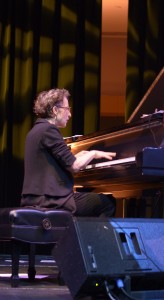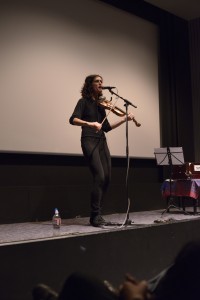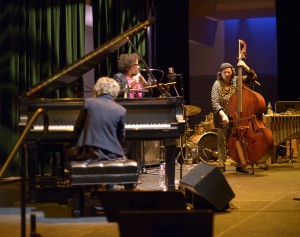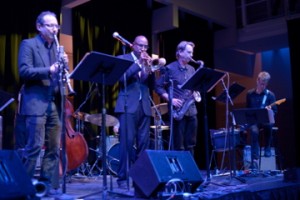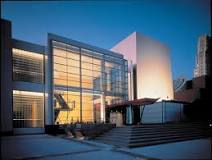Inexhaustible Angelique Kidjo singing her ya-yas out about serious issues amid an onstage throng — the Latin Jazz Youth Ensemble of San Francisco at noon on a Saturday reviving Cuban conga with free-styling dancers — women prominent among the fervently unfettered improvisers and daring composers leading ace ensembles.  The New Frequencies festival: Jazz@YBCA (Yerba Buena Center for the Arts) put this all out last week for a multi-generational Bay Area audience that embraced edgy, energized now music that crossed most genre boundaries.
Subtitled “Jazz in the present tense” the New Frequencies performers — 15 separate acts from Wed., Feb 4 through Sat the 8th (kickoff: drummer Scott Amendola‘s electric string band with guitarists Nels Cline and Jeff Parker, fiddler Jenny Scheinman and bassist John Shifflett was at Duende restaurant in Oakland) — represented the aesthetic vision of YBCA’s artist-in-residence pianist Myra Melford, who curated it in conjunction with YCBA’S associate director of performing arts Isabel Yrigoyen.
Their emphasis was on excellence, originality and expressivity. A sense of community pervaded most of the concerts — especially Kidjo’s, which youthful ticketholders took as an opportunity to jump and shake in support of her urgent singing and patter demanding female education, freedom from sexual mutilation and forced marriages; John Calloway keeping the clavé for the high school age salseros and amateur movers (admission fee: 50 cents) just there for fun, and Henry Threadgill’s Double-Up sextet, which many notable locals musicians and aficionados attended, knowing he’s seldom booked in the Bay Area.
I believe Melford is one of the most remarkable, imaginative and devoted artists currently creating in any musical field or discipline, but disclosure: I’m working on an audience engagement project with her, funded in part by the Doris Duke Performing Artist Awards program. That said, I’ve followed her music closely for 30 years, and my views are informed by observation, personal reaction and analysis rather than compensation. If you suspect otherwise, you may stop believing what you read here.
Besides curating the fest, Melford performed four times, including two tunes on harmonium with Northern California-based fiddler and wry singer-songwriter Scheinman. She made substantial contributions (including explosive solos) to conceptual saxophonist Matana Roberts heritage-diving collage Coin Coin and clarinetist Ben Goldberg’s orchestral, poetic Orphic Machine; she brought her exemplary, expansive keyboard techniques — precise fingering of darting single note runs; rhythmic forearm block-punctuations; tense passages at quiet dynamics; fast and witty responsiveness, sustained melodic lyricism — to a masterfully spontaneous interactive trio with flutist Nicole Mitchell (a star at tunefulness and unusual timbres) and bassist Joelle Leandre (strong and propulsive, bowing and plucking).
But this festival was not about Melford herself. My big discovery was bassist-composer Lisa Mezzacappa’s avantNOIR project, previewed as four 15-to-20 minute pieces jauntily and cinematically evoking (as well as fed by) the crime fiction of Dashiell Hammett and Paul Auster. The score was fast-paced and kaleidoscopic, Mingus-like; the ensemble (percussionist William Winant and synthesist Tim Perkis joining her quartet Bait and Switch) hurtled from one written episode to another but gave each turn its jazz-essential immediacy, as if the music were freshly imagined. avantNOIR speaks directly to my delights, as I recognized specific scenes in The Maltese Falcon (book and movie) which the composition portrayed, and found it refreshing to hear Perkis’ boldly atonal squiggles/swirls/sirens afforded space in a “jazz” context. Mezzacappa played a bass line suggestive of Dolphy’s “Hat and Beard,” too. I want to hear it again! Here’s some video . .
Ben Goldberg’s Orphic Machine, with a cd release imminent, similarly embraced through-composed arrangements and open improvised passages, at one point building to a New Orleans-style collectively improvised climax. In demeanor Goldberg is thoughtful and virtuosic, yet his clarinet retains rawnesss. Wisely casting a front line with Ron Miles’ trumpet and Rob Suddruth on tenor sax, plus Kenny Wolleson on vibes, Melford piano, Nels Cline guitar, Trevor Dunn bass, Ches Smith drums, he introduced song-sculpted settings inspired by “speculative poetics” of the late Allen Grossman. As sung by Carla Kihlstedt, who also played violin, this repertoire had an air of wry yet luxorious inquiry, recalling to me some spirit of Carla Bley and Paul Haines’ long ago collaboration Escalator Over the Hill.Â
Further: Pianist Satoko Fujii and her trumpeter partner Kappa Maki, exploring dissonant clusters, brass blurts and pure tones; drummer Rudy Royston 303’s sophisticated post-bop/pre-electric Miles sextet (soloists Jon Irabagon, tenor; Niles Felder, guitar; Sam Harris, piano, trumpeter Nadje Noordhuis, and two basses: Mimi Jones and Yasushi Nakamura); the trio Grex (billed as an “art-rock/post-jazz trio” — leader Karl Evangelista into Hendrix) and the Elliott Smith Hour, for which Roger Kim arranged movements from Brahms’ Third Symphony for his guitar and banjo, cello, bass clarinet/alto flute and two violins.
The Yerba Buena Center for the Arts is a comfortable, flexible multi-arts space comprising a large auditorium designed mostly for theater and dance; a gym-sized “forum” that could be set with chairs or not as appropriate, and classroom/exhibition spaces. It has seldom ventured into music as nominally radical as New Frequencies intended to be. So it must have been heartened by the evident interests of a sizable crowd for generally adventurous programming. Although a healthy coterie of progressive and experimental musicians lives here, they long like artists everywhere for more opportunities to perform locally. The other regular concentration of such programming, though coming more from the contemporary “classical” and maverick composition side, is the annual Other Minds festival. It runs March 6 through 8, at SFJazz.
howardmandel.com
Subscribe by Email |
Subscribe by RSS |
Follow on Twitter
[contextly_auto_sidebar id=”NxnhNBBJjZqCVVatxSxMKmSp9GYyJfc5″]


